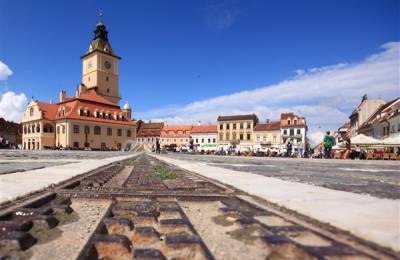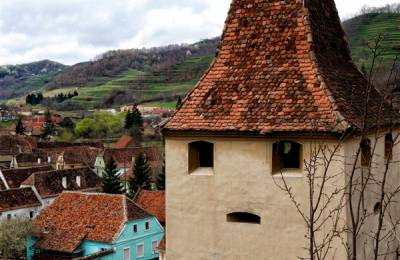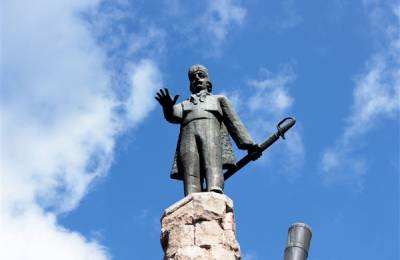Description
The region of Transylvania it lies in the central part of the country, surrounded by the Carpathians which cross Romania. One of the main cities, Cluj-Napoca, stands on the plateau, while Brasov and Sibiu are at the foothills of the southern Carpathians.
`Transylvania` is a latin expression and means the land beyond the forests. Transylvania. Transylvania is one of the most important regions of Romania and of Europe as well. It is one of the provinces of medieval Romania which experienced difficult moments along the centuries. And last, but not least, it is a region rich in natural and historical tourist attractions, being situated inside the arch of the Carpathians. An important tourist attraction associated to the name of Transylvania is the legend about Count Dracula.
In Transylvania is so much to do because here you cand find ski resorts and health spas, hiking trails and the Retezat National Park, fascinating medieval towns, art museums and good hotels.
Attractions
Cluj Napoca
In the heart of Transylvania, Cluj-Napoca awaits its visitors, with the silent full of history walls and hospitable people. Treasures of architecture and years of shaping people’s minds have made this county special in its uniqueness. You’ll see here the famous Transylvanian calm and reflexive mind, seriousness and pride. Come and explore all the ancient and modern beauties and opportunities! Renowned in the past for its richness and also known as “The Treasure City”, Cluj offers nowadays a wide range of possibilities for personal and company development, owing to its geographical position, the local resources and, not least, the skill, education and seriousness of its inhabitants.
Etnografic Museum from Cluj Napoca
The Reduta Palace, the building that houses the Etnographic Mueum - declared a historical monument is located on the Memorandumului Street in Cluj Napoca downtown in the eighteen and nighteenth centuries, in this building there was the most important in in the town, the famous Calul Balan. There are over 12.000.journal and nearly 50.000 photographs relevant to the specific of the museum. Due to the space related restriction the Etnographic Museum representatives are extremely selective in choosing the exhibits so here are hosted the finest carpets, national customs, objects related to the processing of textiles, pottery, grazing, fishing or tools used in farming.
Cheile Turzii- Turzii Gorge
Cheile Turzii is the perfect weekend destination if you want to escapte from the city. In the early spring or autumn is the most suitable period to go on an expedition through the defile created by an afluent of Aries River in Trascau Massif.
Banffy Castle
The Banffy Castle was a jewel of Transylvanian architecture being located in Bontida a commune from Cluj county. Bontida is located at about 30 km from Cluj Napoca. The castle is unique due to a combination of styles that have that have left their mark on the building. Like an medieval castle the Banffy family intialy wanted their residence to provide safety as well, therefore bastions were built in the four conre of the building. Subsequently the nobile residence was rebuilt in the U-shape on to level ground and first floor. The castle was desecrated during World War II by German troops and neglected by the communist ragime in Romania; it is currently being restored by the Transylvania Trust.
Bran Castle
The Bran castle is one of the most beautiful castles from Romania. The building of Bran Castle started somewhere around the year 1378. The constructors somehow succeeded in combining wood with the rock brought from Magura Branului. In the old times the castle had a protective and commercial purpose. It had two rows of walls closing the passing towards South. They were made in stone and brick. Only few traces of the initial defense position still exist. At that time the fortress comprised the exterior wall, the donjon, the round tower and the gate's tower. The wall was built in stone blocks and bricks and had rectangular fire holes as had all Transylvanian fortresses. The donjon was located on the North side and comprised four floors and only two chambers. On the top there was an observation point. Since 1593 the round tower has a circular section. At its pit the ancient inhabitants used to deposit the gun powder. The first and the second floor comprised few chambers. Initially the gate's tower was round, but it was rebuilt in 1625 in rectangular shape. The ancient gate was blocked with beams. The only way of reaching this entrance was by climbing up a ladder. Inside the courtyard you can still see the initial well (57 m high). In 1897 Bram Stoker wrote a terrifying story about Count Dracula. A century after, there are still people who believe in it. Even researchers are trying to find out the truth about Dracula. All are trying to clear the mystery: was there or wasn't there a vampire in Transylvania?
Sibiu
The city of Sibiu is one of the most important cities in Transylvania with a remarkable economic development potential, being also advantaged by its positioning on a traffic knot on the fourth Pan European Corridor and enjoying the benefits of an International Airport.
Known in German as Hermannstadt, Sibiu has always been the centre of Romania's German minority since medieval times. Even today, it contains Romania's largest German community, and, due to initiatives by the local government, the Germanic feel of the area has been maintained. Sibiu/Hermannstadt is perceived as a city of art and culture. A great number of cultural monuments, a diversity of museums, and various artistic and cultural events, make up the pillars of a complex cultural profile.
Known in German as Hermannstadt, Sibiu has always been the centre of Romania's German minority since medieval times. Even today, it contains Romania's largest German community, and, due to initiatives by the local government, the Germanic feel of the area has been maintained. Sibiu/Hermannstadt is perceived as a city of art and culture. A great number of cultural monuments, a diversity of museums, and various artistic and cultural events, make up the pillars of a complex cultural profile.
Using this simple premise, an attractive and stimulating atmosphere has been created for residents and visitors who take the opportunity to experience cultural life in this Transylvanian city. Today, old Sibiu still possesses much of its erstwhile charm, a character carefully preserved for posterity, and subject of several high-profile restoration projects. It is also an easy city to explore on foot, one with a good selection of restaurants, pavement cafes and beer gardens. Some of the main sights from Sibiu are: The Council Tower, the Arts House, The Old Town Hall, The liars Bridge, the big Square, the Small Square and the Evangelic Church the museums etc. We also have to mention the sights around Sibiu like the mountain ski resort Paltinis, Ocna Sibiului- a spa resort with salty baths, and Marginimea Sibiului. In a larger sense, the region called Marginimea Sibiului represents a geographical historical and ethnographical entity, including the chain of Romanian villages situated at the feet of Sibiu Mountains. The following localities belong to the region called Marginimea Sibiului: Boita, Sadu, Rau Sadului, Talmaciu, Talmacel, Rasinari, Poplaca, Gura Raului, Orlat, Fantanele, Sibiel, Vale, Saliste, Gales, Tilisca, Rod, Poiana Sibiului and Jina. The greatest part of the villages in the area has preserved strong spiritual and ethno - folkloric traditions, conferring to these communities a specific aspect. The wonderful geographic site, the purity of the people and of the nature, the richness and the diversity of the cultural patrimony, turn this place into a region with a great touristic potential.
Fortified Churches
Biertan
Biertan was among the first settlements established by Saxons in Transylvania. The village’s first historic records appear in documents from 1283. For almost three centuries (1527-1867) Biertan was he headquarters of the Transylvania Saxon episcopacy, wich approved the construction of one of Transylvania’s strongest village fortresses around Biertan’s fortified church. In 1993, the site won UNESCO World Heritage status. Tourists cand take part in a medieval Treasure Hunt, with cues, mystery trails and archery. For those who would want to explore the trails in the area, rental bikes are available. The valleys also feature many mountain biking routes, including Biertan to Copsa Mare, Biertan to Richis.
Viscri
Nine kilometers from the national road between Brasov and Sighisoara, the Saxon fortess in Viscri village is the oldest, best preserved and perhaps most spectacular village, surrounded by o fortress in Transylvania. It sits on a hill in the village surrounded by a forest. With stone foundations and wooden upper sections, the fortress comprises two barricading walls and four towers. Carefully restored, this medieval building is perhaps the best representation of Saxon influence to be found in Transylvania. Viscri is the only village in Romania included on the UNSECO World Heritage list. Restored houses are the same shade of blue they were centuries ago, and visitors cand stay in guest houses with authentic Saxon furniture and sample traditional sample dishes. On a walk through the neighbouring forest, you may see deer or wild boars.
Corvinilor Castle
Legenderily considered one of the world’s scariest buildings, Corvibnilor Castle, also known as Huniazilor Castle in in fact the medieval fortress of Hunedoara, built in the 15th century and one of Transylvania’s most important Gothic architectural monuments. The fortress was built by John Hunyadi, one of Europe’s most impotant military and political leaders of the 15th century and father of the most famous Hungarian king, Matei Corvin. Over time, the building underwent important transformations, serving as both strategic fortification and feudal residence.










